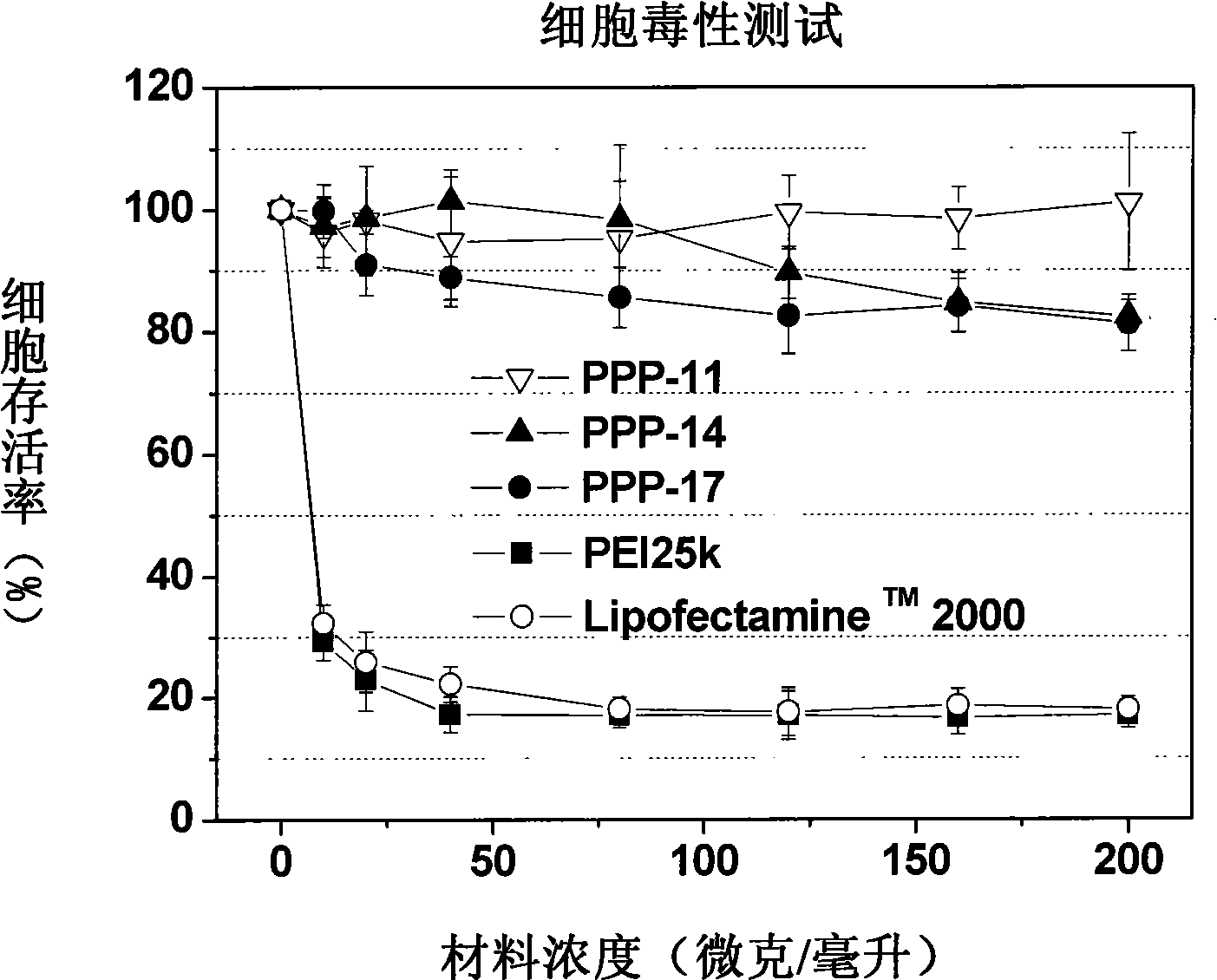Polyethylene glycol monomethyl ether-poly 2-methyl-carboxyl propylene carbonate graft polyethyleneimine copolymer, preparation method thereof and application thereof
A technology of polyethyleneimine copolymer and polyethylene glycol monomethyl ether, which is applied to polyethyleneimine copolymer and polyethylene glycol monomethyl ether-poly2-methyl-2-carboxypropylene carbonate grafted with polyethyleneimine. The preparation method and application field can solve the problems of non-degradability and high cytotoxicity, and achieve the effects of high use value, high transfection efficiency and low cytotoxicity.
- Summary
- Abstract
- Description
- Claims
- Application Information
AI Technical Summary
Problems solved by technology
Method used
Image
Examples
Embodiment 1
[0037] Embodiment 1: Preparation of polyethylene glycol monomethyl ether-poly 2-methyl-2-carboxypropylene carbonate block copolymer
[0038] Respectively according to the charging amount listed in Table 1, take by weighing polyethylene glycol monomethyl ether (mPEG) with a number average molecular weight of 5000 5000 ) and 2-methyl-2-benzyloxycarbonyl propylene carbonate (MBC), the two are fed into different dry reactors, respectively add 300ml of anhydrous toluene at 130 ° C to azeotropically remove water for 5 hours, azeotropically After the water removal is completed, part of the toluene is evaporated at a temperature of 130°C, and the volume of the remaining toluene is 50ml as the end point of each distillation; the catalyst diethylzinc is dissolved in anhydrous toluene at a molar concentration of 0.2mmol / ml, respectively Add diethylzinc / toluene solution to the corresponding reactor according to the diethylzinc charging amount in table 1, and follow the polymerization temp...
Embodiment 2
[0041] Embodiment 2: Preparation of polyethylene glycol monomethyl ether-poly2-methyl-2-carboxypropylene carbonate grafted polyethyleneimine copolymer
[0042] Weigh the corresponding feeding amount according to the type of mPEG-b-PMCC listed in Table 2, feed into different reactors together with the dimethyl sulfoxide of the corresponding reaction volume described in Table 2, stir and dissolve, According to the type of polyethyleneimine (PEI) shown in Table 2 and the molar amount of feed, PEI was weighed respectively and added to the corresponding reactor, and then according to the molar amount of feed shown in Table 2, 1-(3 -Dimethylaminopropyl)-3-ethylcarbodiimide hydrochloride (EDC.HCl) is also added to the corresponding reactor, the temperature is controlled at 25°C, and the reaction is carried out with stirring according to the reaction time in Table 2. , after the reaction was completed, the reaction solution was respectively loaded into a dialysis bag with a molecular ...
Embodiment 3
[0045] Example 3: Polyethylene glycol monomethyl ether-poly 2-methyl-2-carboxypropylene carbonate grafted polyethyleneimine copolymer mediated luciferase plasmid to African green monkey kidney cells (Cos-7 cells) in vitro transfection
[0046] 1. Cos-7 cell culture
[0047] The Cos-7 cells were placed in a culture solution containing 10% fetal bovine serum by volume, and continuously cultured in an incubator containing 5% carbon dioxide by volume at 37°C.
[0048] 2. In vitro transfection
[0049] (1) No serum transfection
[0050] Within 24 hours before transfection, take Cos-7 cells in the logarithmic growth phase, digest with trypsin and dilute with DMEM at 1×10 per well 4 Cells were seeded in 96-well culture plates at a density of 37°C in an incubator containing 5% carbon dioxide by volume and continued to culture until the confluence reached 80-90%. During transfection, discard the culture medium in the cell culture plate added the day before, wash twice with phosphat...
PUM
 Login to View More
Login to View More Abstract
Description
Claims
Application Information
 Login to View More
Login to View More - R&D
- Intellectual Property
- Life Sciences
- Materials
- Tech Scout
- Unparalleled Data Quality
- Higher Quality Content
- 60% Fewer Hallucinations
Browse by: Latest US Patents, China's latest patents, Technical Efficacy Thesaurus, Application Domain, Technology Topic, Popular Technical Reports.
© 2025 PatSnap. All rights reserved.Legal|Privacy policy|Modern Slavery Act Transparency Statement|Sitemap|About US| Contact US: help@patsnap.com



